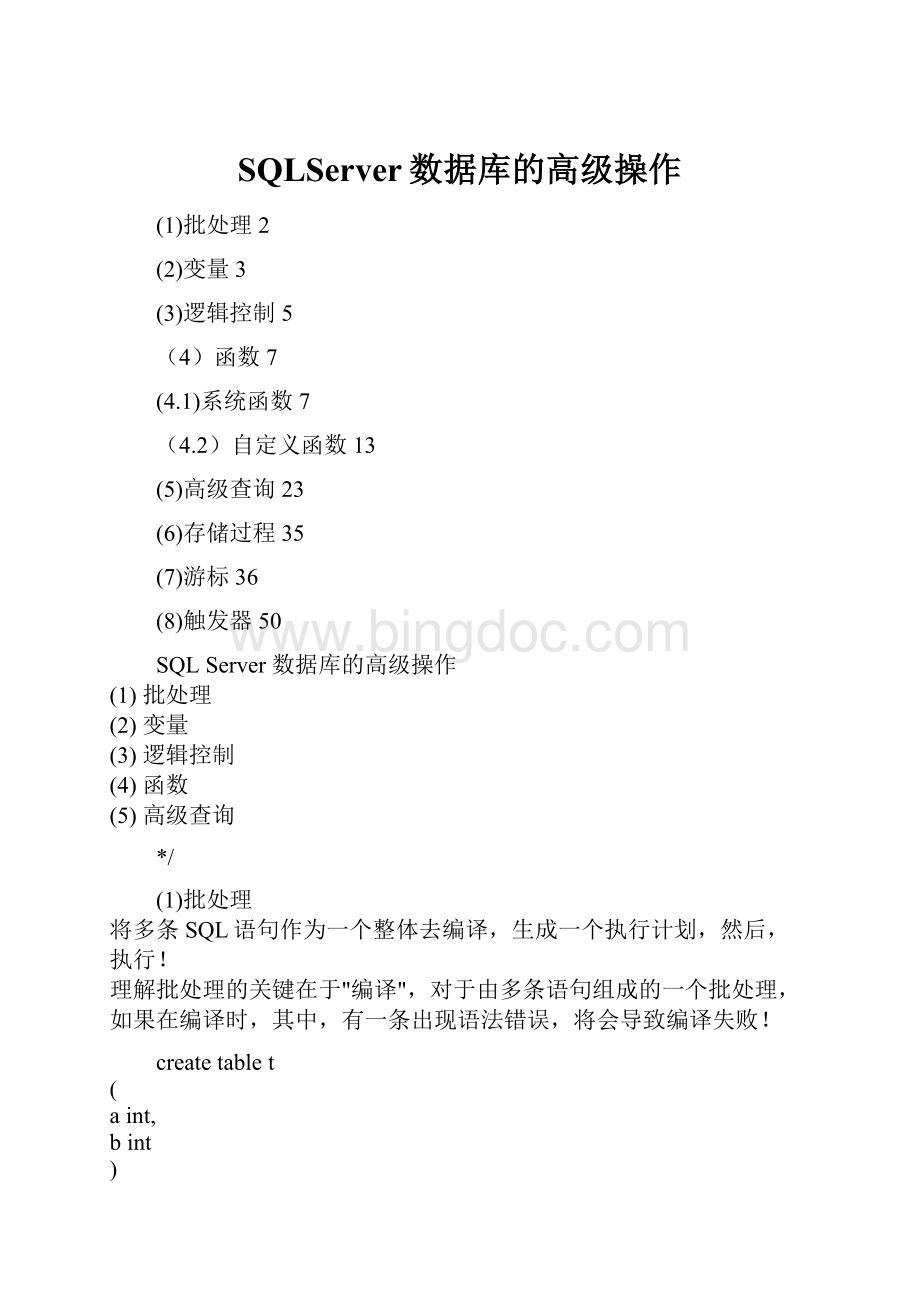SQLServer数据库的高级操作.docx
《SQLServer数据库的高级操作.docx》由会员分享,可在线阅读,更多相关《SQLServer数据库的高级操作.docx(32页珍藏版)》请在冰点文库上搜索。

SQLServer数据库的高级操作
(1)批处理2
(2)变量3
(3)逻辑控制5
(4)函数7
(4.1)系统函数7
(4.2)自定义函数13
(5)高级查询23
(6)存储过程35
(7)游标36
(8)触发器50
SQLServer数据库的高级操作
(1)批处理
(2)变量
(3)逻辑控制
(4)函数
(5)高级查询
*/
(1)批处理
将多条SQL语句作为一个整体去编译,生成一个执行计划,然后,执行!
理解批处理的关键在于"编译",对于由多条语句组成的一个批处理,
如果在编译时,其中,有一条出现语法错误,将会导致编译失败!
createtablet
(
aint,
bint
)
--注释
--如果多行注释中包含了批处理的标识符go
--在编译的过程中代码将会被go分割成多个部分来分批编译
--多行注释的标记将会被分隔而导致编译出错
--以下几条语句是三个非常经典的批处理
--你猜一下会添加几条记录!
/*
insertintotvalues(1,1)
go
*/
insertintotvalues(2,2)
go
/*
insertintotvalues(3,3)
*/
go
--查询看添加了几条记录
select*fromt
truncatetablet
(2)变量
--全局变量
SQLServer中全局变量由系统定义、系统维护,用户一般仅可对其进行读取!
--查看SQLServer版本
print@@version
--服务器名称
print@@servername
--系统错误编号
insertintotvalues('a','a')
print@@error
insertintotvalues('a','a')
if@@error=245
print'Error'
--SQLServer版本的语言信息
print@@LANGUAGE
--一周的第一天从星期几算起
print@@datefirst
--CPU执行命令所耗费时间的累加
print@@cpu_busy
--获取最近添加的标识列的值
createtablett
(
aintidentity(3,10),
bint
)
insertintott(b)values
(1)
print@@identity
select*fromtt
--局部变量
局部变量由用户定义,仅可在同一个批处理中调用和访问
declare@intAgetinyint
set@intAge=12
print@intAge
declare@strNamevarchar(12)
select@strName='state'
print@strName
selectau_lname,@strNamefromauthors
(3)逻辑控制
--IF条件判断
declare@iint
set@i=12
if(@i>10)
begin --{
print'Dadadada!
'
print'Dadadada!
'
end --}
else
begin
print'XiaoXiao!
'
print'XiaoXiao!
'
end
--While循环控制
declare@iint;
set@i=12;
print@i
return;
while(@i<18)
begin
print@i;
set@i=@i+1;
if@i<17
continue;
if@i>15
break;
end;
--CASE分支判断
selectau_lname,state,'犹他州'fromauthorswherestate='UT'
selectau_lname,state,'密西西比州'fromauthorswherestate='MI'
selectau_lname,state,'肯塔基州'fromauthorswherestate='KS'
selectau_lname,state,
casestate
when'UT'then'犹他州'
when'MI'then'密西西比州'
when'KS'then'肯塔基州'
when'CA'then'加利福利亚'
elsestate
end
fromauthors
(4)函数
(4.1)系统函数
--获取指定字符串中左起第一个字符的ASC码
printascii('ABCDEF')
--根据给定的ASC码获取相应的字符
printchar(65)
--获取给定字符串的长度
printlen('abcdef')
--大小写转换
printlower('ABCDEF')
printupper('abcdef')
--去空格
printltrim(' abcd dfd df ')
printrtrim(' abcd dfd df ')
--求绝对值
printabs(-12)
--幂
--3的2次方
printpower(3,2)
printpower(3,3)
--随机数
--0-1000之间的随机数
printrand()*1000
--获取圆周率
printpi()
--获取系统时间
printgetdate()
--获取3天前的时间
printdateadd(day,-3,getdate())
--获取3天后的时间
printdateadd(day,3,getdate())
--获取3年前的时间
printdateadd(year,-3,getdate())
--获取3年后的时间
printdateadd(year,3,getdate())
--获取3月后的时间
printdateadd(month,3,getdate())
--获取9小时后的时间
printdateadd(hour,9,getdate())
--获取9分钟后的时间
printdateadd(minute,9,getdate())
--获取指定时间之间相隔多少年
printdatediff(year,'2005-01-01','2008-01-01')
--获取指定时间之间相隔多少月
printdatediff(month,'2005-01-01','2008-01-01')
--获取指定时间之间相隔多少天
printdatediff(day,'2005-01-01','2008-01-01')
--字符串合并
print'abc'+'def'
print'abcder'
print'abc'+'456'
print'abc'+456
--类型转换
print'abc'+convert(varchar(10),456)
selecttitle_id,type,pricefromtitles
--字符串连接必须保证类型一致(以下语句执行将会出错)
--类型转换
selecttitle_id+type+pricefromtitles
--正确
selecttitle_id+type+convert(varchar(10),price)fromtitles
print'123'+convert(varchar(3),123)
print'123'+'123'
printconvert(varchar(12),'2005-09-01',110)
--获取指定时间的特定部分
printyear(getdate())
printmonth(getdate())
printday(getdate())
--获取指定时间的特定部分
printdatepart(year,getdate())
printdatepart(month,getdate())
printdatepart(day,getdate())
printdatepart(hh,getdate())
printdatepart(mi,getdate())
printdatepart(ss,getdate())
printdatepart(ms,getdate())
--获取指定时间的间隔部分
--返回跨两个指定日期的日期和时间边界数
printdatediff(year,'2001-01-01','2008-08-08')
printdatediff(month,'2001-01-01','2008-08-08')
printdatediff(day,'2001-01-01','2008-08-08')
printdatediff(hour,'2001-01-01','2008-08-08')
printdatediff(mi,'2001-01-01','2008-08-08')
printdatediff(ss,'2001-01-01','2008-08-08')
--在向指定日期加上一段时间的基础上,返回新的datetime值
printdateadd(year,5,getdate())
printdateadd(month,5,getdate())
printdateadd(day,5,getdate())
printdateadd(hour,5,getdate())
printdateadd(mi,5,getdate())
printdateadd(ss,5,getdate())
--其他
printhost_id()
printhost_name()
printdb_id('pubs')
printdb_name(5)
--利用系统函数作为默认值约束
droptablettt
createtablettt
(
stu_name varchar(12),
stu_birthday datetimedefault(getdate())
)
altertablettt
addconstraintdf_ttt_stu_birthdaydefault (getdate())forstu_birthday
insertintotttvalues('ANiu','2005-04-01')
insertintotttvalues('ANiu',getdate())
insertintotttvalues('AZhu',default)
sp_helpttt
select*fromttt
(4.2)自定义函数
selecttitle_id
fromtitles
wheretype='business'
selectstuff(title_id,1,3,'ABB'),type
fromtitles
wheretype='business'
selectcount(title_id)fromtitleswheretype='business'
selecttitle_idfromtitleswheretype='business'
select *,count(dbo.titleauthor.title_id)
FROMdbo.authorsINNERJOIN
dbo.titleauthorONdbo.authors.au_id=dbo.titleauthor.au_id
selectau_id,count(title_id)
fromtitleauthor
groupbyau_id
SELECTdbo.authors.au_id,COUNT(dbo.titleauthor.title_id)AS'作品数量'
FROMdbo.authors leftouterJOIN
dbo.titleauthorONdbo.authors.au_id=dbo.titleauthor.au_id
GROUPBYdbo.authors.au_id
orderby'作品数量'
--自定义函数的引子(通过这个子查询来引入函数的作用)
--子查询
--统计每个作者的作品数
--将父查询中的作者编号传入子查询
--作为查询条件利用聚合函数count统计其作品数量
selectau_lname,
(selectcount(title_id)
fromtitleauthorasta
whereta.au_id=a.au_id
)asTitleCount
fromauthorsasa
orderbyTitleCount
--是否可以定义一个函数
--将作者编号作为参数统计其作品数量并将其返回
selectau_id,au_lname,dbo.GetTitleCountByAuID(au_id)asTitleCount
fromauthors
orderbyTitleCount
--根据给定的作者编号获取其相应的作品数量
createfunctionGetTitleCountByAuID(@au_idvarchar(12))
returnsint
begin
return(selectcount(title_id)
fromtitleauthor
whereau_id=@au_id)
end
--利用函数来显示每个作者的作品数量
createprocpro_CalTitleCount
as
selectau_id,au_lname,dbo.GetTitleCountByAuID(au_id)asTitleCount
fromauthors
orderbyTitleCount
go
--执行存储过程
executepro_CalTitleCount
--vb中函数定义格式
functionGetTitleCountByAuID(au_idasstring)asinteger
.......
GetTitleCountByAuID=?
endfunction
--SALES作品销售信息
select*fromsales
--根据书籍编号查询其销售记录(其中,qty表示销量)
select*fromsaleswheretitle_id='BU1032'
--根据书籍编号统计其总销售量(其中,qty表示销量)
selectsum(qty)fromsaleswheretitle_id='BU1032'
--利用分组语句(groupby),根据书籍编号统计每本书总销售量(其中,qty表示销量)
selecttitle_id,sum(qty)fromsalesgroupbytitle_id
--是否可以考虑定义一个函数根据书籍编号来计算其总销售量
--然后,将其应用到任何一条包含了书籍编号的查询语句中
selecttitle_id,title,dbo.GetTotalSaleByTitleID(title_id)asTotalSales
fromtitles
orderbyTotalSales
--定义一个函数根据书籍编号来计算其总销售量
createfunctionGetTotalSaleByTitleID(@tidvarchar(24))
returnsint
begin
return(selectsum(qty)fromsaleswheretitle_id=@tid)
end
--统计书籍销量的前10位
--其中,可以利用函数计算结果的别名作为排序子句的参照列
selecttop10title_id,title,dbo.GetTotalSaleByTitleID(title_id)asTotalSales
fromtitles
orderbyTotalSalesdesc
--根据书籍编号计算其销量排名
createfunctionGetTheRankOfTitle(@idvarchar(20))
returnsint
begin
return(selectcount(TotalSales)
fromtitles
whereToalSales>(
selectTotalSales
fromtitles
wheretitle_id=@id))
end
--根据书籍编号计算其销量排名
selectdbo.GetTheRankOfTitle('pc1035')fromtitles
selectcount(title_id)+1
fromtitles
wheredbo.GetTotalSaleByTitleID(title_id)>dbo.GetTotalSaleByTitleID('pc1035')
--删除函数
dropfunctionGetRankByTitleId
--根据书籍编号计算其销量排名
createfunctionGetRankByTitleId(@tidvarchar(24))
returnsint
begin
return(selectcount(title_id)+1
fromtitles
wheredbo.GetTotalSaleByTitleID(title_id)>dbo.GetTotalSaleByTitleID(@tid))
end
--在查询语句中利用函数统计每本书的总销量和总排名
selecttitle_id,title,
dbo.GetTotalSaleByTitleID(title_id)asTotalSales,
dbo.GetRankByTitleId(title_id)asTotalRank
fromtitles
orderbyTotalSalesdesc
--查看表结构
sp_helptitles
--查看存储过程的定义内容
sp_helptextGetRankByTitleId
sp_helptextsp_helptext
sp_helptextxp_cmdshell
--[ORDERDETAILS]订单详细信息
select*from[orderdetails]
select*from[orderdetails]whereproductid=23
--根据产品编号在订单详细信息表中统计总销售量
selectsum(quantity)from[orderdetails]whereproductid=23
--构造一个函数根据产品编号在订单详细信息表中统计总销售量
createfunctionGetTotalSaleByPID(@Pidvarchar(12))
returnsint
begin
return(selectsum(quantity)from[orderdetails]whereproductid=@Pid)
end
select*fromproducts
--在产品表中查询,统计每一样产品的总销量
selectproductid,productname,dbo.GetTotalSaleByPID(productid)fromproducts
--
CREATEFUNCTIONLargeOrderShippers(@FreightParmmoney)
RETURNS@OrderShipperTabTABLE
(
ShipperID int,
ShipperName nvarchar(80),
OrderID int,
ShippedDate datetime,
Freight money
)
AS
BEGIN
INSERT@OrderShipperTab
SELECTS.ShipperID,S.CompanyName,
O.OrderID,O.ShippedDate,O.Freight
FROMShippersASSINNERJOINOrdersASO
ONS.ShipperID=O.ShipVia
WHEREO.Freight>@FreightParm
RETURN
END
SELECT*FROMLargeOrderShippers($500)
--根据作者编号计算其所得版权费
createfunctionfun_RoyalTyper(@au_idid)
returnsint
as
begin
declare@rtint
select@rt=sum(royaltyper)fromtitleauthorwhereau_id=@au_id
return(@rt)
end
go
selecttop1au_lname,au_fname,dbo.fun_RoyalTyper(au_id)as'版权费'
fromauthors
orderby dbo.fun_RoyalTyper(au_id)desc
go
createfunctionfun_MaxRoyalTyper_Au_id()
returnsid
as
begin
declare@au_idid
select@au_id=au_id
fromauthors
orderby dbo.fun_RoyalTyper(au_id)
return(@au_id)
end
go
selectdbo.fun_MaxRoyalTyper_Au_id()
go
selectau_l